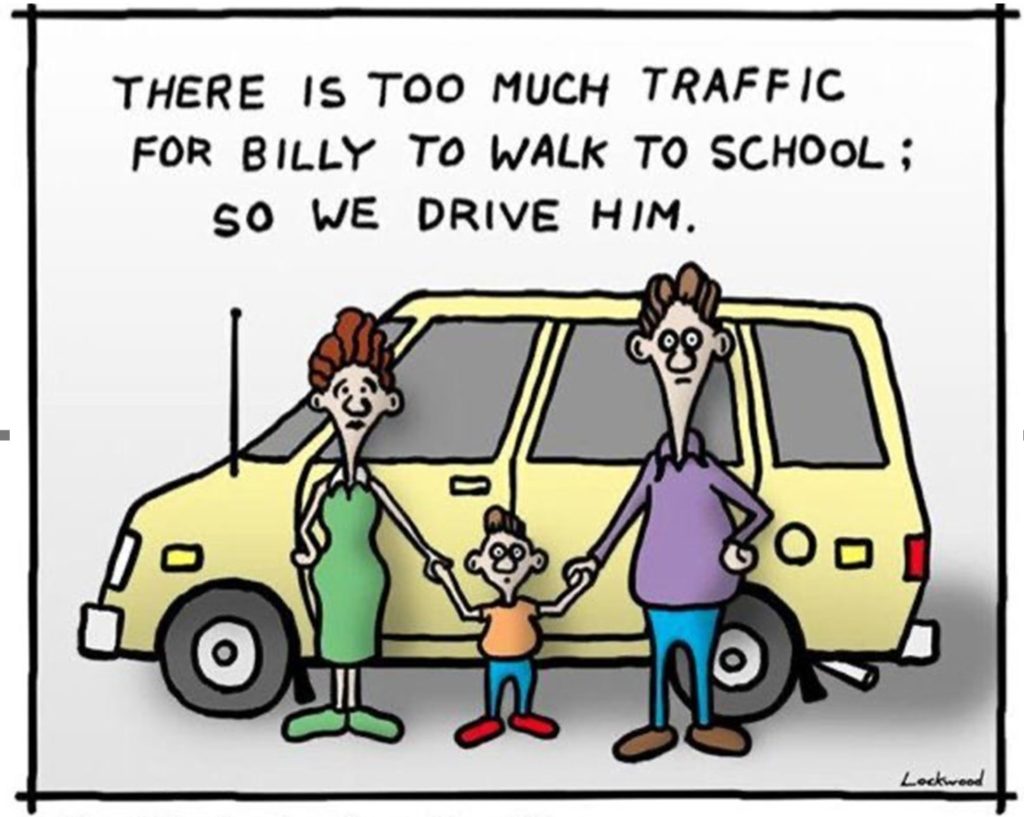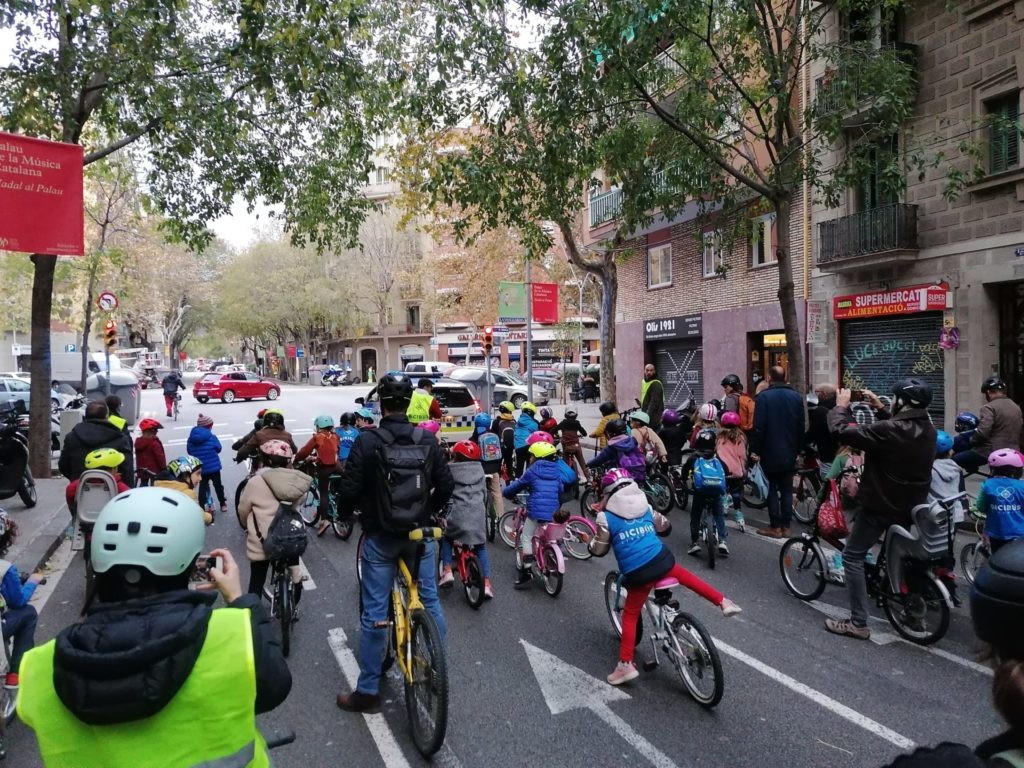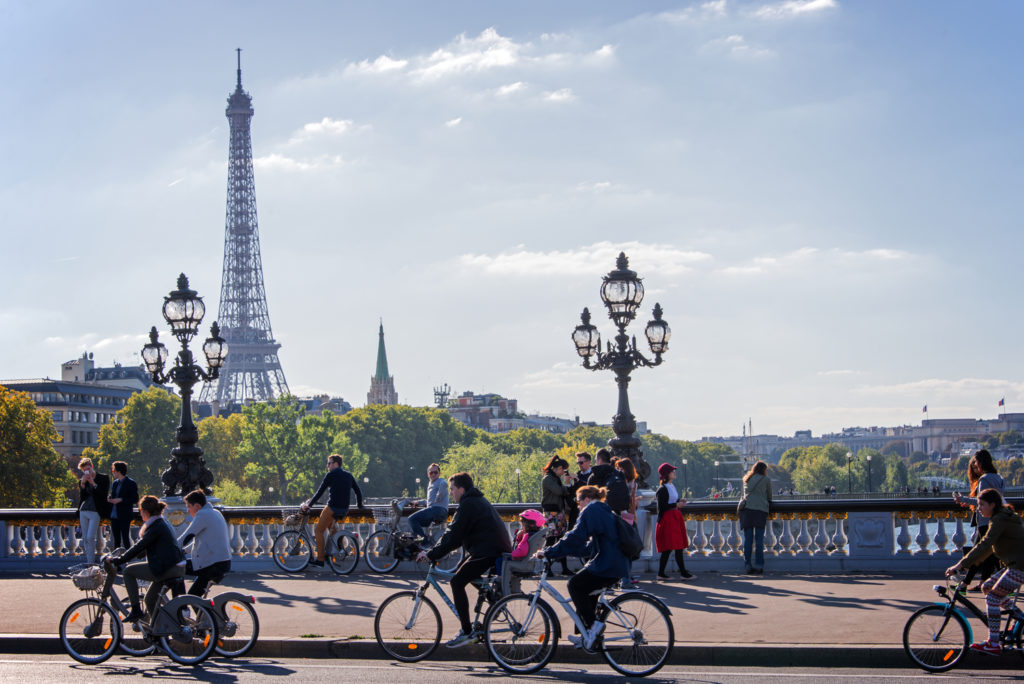

Pedal Power
The bicycle is the most efficient transport machine ever invented.
Did you know that the bicycle is the world’s most widely used transport machine? Worldwide, bicycles outnumber automobiles almost two to one. Why is the bicycle so popular?


You can go farther for the same amount of energy on a bike than you can with any other means of transport.
A bicycle goes 3,000 miles on the energy equivalent of one gallon of gasoline. The most fuel-efficient cars go only about 100 miles on a gallon of gas. A person riding a bike can also travel farther on the same amount of energy than any other animal on the planet. Biking is more efficient than walking, running, swimming, or even skating. It takes about three times as much energy to walk, for example, as it does to bike the same distance.
How can Superblocks turn urban neighborhoods into villages?
Designed by the Barcelona City Council in collaboration with the Urban Ecology Agency, the Superilles (Superblocks in English) of the Spanish city of Barcelona have proven to be an effective plan to free up the urban space for other uses than automobile traffic and offer a more sustainable living to the inhabitants.
This video is the second of a series of five on the Superblocks, in which the urban planner – also one of the drivers of the Superblocks concept – Salvador Rueda describes all the key aspects and benefits of those traffic-free neighborhoods. In this video, he explains how human interactions are at the heart of the Superblocks. #Superblocks #SustainableLiving
What is EIT Urban Mobility? A European initiative to create liveable urban spaces! EIT Urban Mobility, supported by the European Institute of Innovation and Technology (EIT), acts to accelerate positive change on mobility to make urban spaces more liveable. Learn more about EIT Urban Mobility: https://www.eiturbanmobility.eu/

Cada cop som més bicicletes al #bicibús Letamendi! En aquest vídeo el moment de l’arribada a l’escola Auró. Gràcies per participar-hi famílies! @AfaAuro @ampaipsi @AFI_Entenca @AFAXirinacs
🚲🛴🚲🛴🚲🛴#FridaysForBike #Bicivendres #OmplimDeBicisLesEscoles pic.twitter.com/ieauqfFxMD— Bicibús Eixample (@bicibuseixample) December 11, 2021


To make cities inclusive, safe, resilient and sustainable they should be made for walking, bicycling and public transport, not for cars (even not for electric cars as they take up the exact same space as petrol cars).
Paris to Become “One of the Most Bike-Friendly Cities in the World”
ArchDaily: The city of Paris has announced that it will be investing €250 million to upgrade its cycling infrastructure and expand its network of bike lanes with aim of becoming “100% cyclable”. The French capital’s investment comes through Bike Plan, a 5-year-long urban project that will reinforce the presence of bikes and provide safe and well-connected routes for passengers and pedestrians.
The expansion plans come after a noticeable amount of Parisians took interest in biking during the pandemic instead of their regular commuting means. Today, the city sees almost 1 million bike journeys on a daily basis without the proper infrastructure to cater to this amount.
10 Keys to Making A Great City Plan
(Just got another request to advise on a new plan, in this case another regional plan in Australia, from someone who read this. Some consultants told me I “shouldn’t have given this away.” I don’t see it that way.)https://t.co/roGmXeTjB9 pic.twitter.com/0lyjwcIbo4
— Brent Toderian (@BrentToderian) September 2, 2021
A new study reveals that Dutch residents are the most physically active on earth, getting 12.8 hours of exercise each week. The key — designing activity into daily life. The average #Dutch person cycles about 1,098 kilometers per year. HT @Cycling_Embassyhttps://t.co/M9YSD5Avl7 pic.twitter.com/HnPTCASzAO
— Brent Toderian (@BrentToderian) November 17, 2021
“Cycle commuters had a 52% lower risk of dying from heart disease and a 40% lower risk of dying from cancer. They also had 46% lower risk of developing heart disease and a 45% lower risk of developing cancer at all.” Via @ConversationUK https://t.co/yTicwVvDAq
— Brent Toderian (@BrentToderian) October 11, 2020
Possibly the most powerful way to inspire the transformation of cities from spaces for cars to places for people is to show what cities have already transformed! Except what you can’t tell from before-&-after photos is that vehicle traffic often actually gets BETTER. HT @iamcais pic.twitter.com/lUIpLMR33C
— Brent Toderian (@BrentToderian) December 9, 2021
They say “We can’t do that. We’re not Amsterdam.” You reply “Amsterdam wasn’t always like that either” & show before & after transformations illustrating how cities we admire made CHOICES. They try new excuses. You don’t accept them either. (1e van der Helststraat, 1978 & 2005) pic.twitter.com/ewtc3wb3Wy
— Brent Toderian (@BrentToderian) December 4, 2021
People often respond to proposals to turn road apace back to people space with anger at the change, yet so many places around the world that we now take for granted went through this transition. One case in point: Washington Square in NYC. Please share your examples! pic.twitter.com/ruvaQOVw2w
— Greg Vann (@GregVann) October 10, 2021

United Nations Global Goals for Sustainable Development
The world is becoming increasingly urbanized. Since 2007, more than half the world’s population has been living in cities, and that share is projected to rise to 60 percent by 2030.
Cities and metropolitan areas are powerhouses of economic growth—contributing about 60 percent of global GDP. However, they also account for about 70 percent of global carbon emissions and over 60 percent of resource use.
Rapid urbanization is resulting in a growing number of slum dwellers, inadequate and overburdened infrastructure and services (such as waste collection and water and sanitation systems, roads and transport), worsening air pollution, and unplanned urban sprawl.
The impact of COVID-19 will be most devastating in poor and densely populated urban areas, especially for the one billion people living in informal settlements and slums worldwide, where overcrowding also makes it difficult to follow recommended measures such as social distancing and self-isolation.
The UN food agency, FAO, warned that hunger and fatalities could rise significantly in urban areas, without measures to ensure that poor and vulnerable residents have access to food.
COVID-19 response
Cities are on the front line of coping with the pandemic and its lasting impacts. Across the globe, COVID-19 is threatening cities and communities, endangering not only public health but also the economy and the fabric of society.
UN-Habitat, the UN agency for housing and urban development, is working with national and local governments to help them prepare for, prevent, respond to and recover from the COVID-19 pandemic. The UN Habitat COVID-19 Response Plan aims to:
- Support local governments and community-driven solutions in informal settlements
- Provide urban data, evidence-based mapping and knowledge for informed decision
- Mitigate economic impact and initiate recovery
UN-Habitat’s COVID-19 Policy and Programme Framework provides guidance for global, regional, and country-level action.
The UN Economic Commission for Africa has proposed specific support to city governments to mitigate and respond to the economic effects of COVID-19. Africa’s cities account for more than 50% of the region’s GDP, and COVID-19 is likely to hit African cities hard, with sharp declines in productivity, jobs, and revenues.
Facts and Figures
- Half of humanity – 3.5 billion people – lives in cities today and 5 billion people are projected to live in cities by 2030.
- 95 percent of urban expansion in the next decades will take place in developing world
- 828 million people live in slums today and most them are found in Eastern and South-Eastern Asia.
- The world’s cities occupy just 3 per cent of the Earth’s land, but account for 60-80 percent of energy consumption and 75 per cent of carbon emissions.
- Rapid urbanization is exerting pressure on fresh water supplies, sewage, the living environment, and public health.
- Cities account for between 60 and 80 per cent of energy consumption and generate as much as 70 percent of human-induced greenhouse gas emissions
- 90 percent of urban growth is forecasted to happen in Asia and Africa in the next 30 years.
- By 2050 70 percent of the world population is predicted to live in urban settlements.
Goal 11 Targets
11.1 By 2030, ensure access for all to adequate, safe, and affordable housing and basic services and upgrade slums
11.2 By 2030, provide access to safe, affordable, accessible, and sustainable transport systems for all, improving road safety, notably by expanding public transport, with special attention to the needs of those in vulnerable situations, women, children, persons with disabilities, and older persons
11.3 By 2030, enhance inclusive and sustainable urbanization and capacity for participatory, integrated, and sustainable human settlement planning and management in all countries
11.4 Strengthen efforts to protect and safeguard the world’s cultural and natural heritage
11.5 By 2030, significantly reduce the number of deaths and the number of people affected and substantially decrease the direct economic losses relative to the global gross domestic product caused by disasters, including water-related disasters, with a focus on protecting the poor and people in vulnerable situations
11.6 By 2030, reduce the adverse per capita environmental impact of cities, including by paying special attention to air quality and municipal and other waste management
11.7 By 2030, provide universal access to safe, inclusive, and accessible, green and public spaces, in particular for women and children, older persons, and persons with disabilities
11.A Support positive economic, social, and environmental links between urban, peri-urban, and rural areas by strengthening national and regional development planning
11.B By 2020, substantially increase the number of cities and human settlements adopting and implementing integrated policies and plans towards inclusion, resource efficiency, mitigation and adaptation to climate change, resilience to disasters, and develop and implement, in line with the Sendai Framework for Disaster Risk Reduction 2015-2030, holistic disaster risk management at all levels
11.C Support least developed countries, including through financial and technical assistance, in building sustainable and resilient buildings utilizing local materials.
The United Nations Conference on Housing and Sustainable Urban Development took place in Quito, Ecuador from 17-20 October 2016, and was the first UN global summit on urbanization since the adoption of the 2030 Agenda for Sustainable Development.
Habitat III offered a unique opportunity to discuss the important challenges of how cities, towns, and villages can be planned and managed, in order to fulfill their role as drivers of sustainable development, and how they can shape the implementation of the Sustainable Development Goals and the Paris Agreement on climate change.
In Quito, world leaders adopted the New Urban Agenda which set global standards of achievement in sustainable urban development, rethinking the way we build, manage, and live in cities through drawing together cooperation with committed partners, relevant stakeholders, and urban actors at all levels of government as well as the civil society and private sector.
Links
UN Environment Programme : Cities – investing in energy and resource efficiency
UN Environment Programme Climate Neutral Network
UN Environment Programme: Cities and Climate Change






2 Comments
Pingback: Can you think of a less efficient way to transport people through your city than cars? - Bergensia
Pingback: meditation music